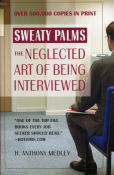| What REALLY goes on in a job interview? Find out in the new revision of "Sweaty Palms: The Neglected Art of Being Interviewed" by Tony Medley, updated for the world of the Internet . Over 500,000 copies in print and the only book on the job interview written by an experienced interviewer, one who has conducted thousands of interviews. This is the truth, not the ivory tower speculations of those who write but have no actual experience. "One of the top five books every job seeker should read," says Hotjobs.com. Click the book to order. Now also available on Kindle. | |
|
The Man Who Knew Infinity (7/10) by Tony Medley Runtime 108 minutes OK for children. Srinavasa Ramanujan was a legendary mathematician who lived 1887-1920. This film, in which he is played by Dev Patel (known mostly for the Exotic Marigold Hotel and Slumdog Millionaire movies), telegraphs that it makes up a lot of facts by stating that it is “based on” a true story. It gets the basic story from the book of the same name by Robert Kanigel, who spent substantial time with Ramanujan’s widow, who was 90 years old at the time (Ramanujan married her when he was 22 and she was 10 [some say 9]). But, clearly, it has been “Hollywooded” up. Ramanujan is a clerk in Mardras, who, Einstein-like, writes down his theorem in notebooks. He gets a reputation in India and eventually sends his notebooks to several mathematicians in England. Most ignore him but one, G.H. Hardy, recognizes his genius and urges him to come to England. Ramanujan was really a savant, a person who perceived mathematics intuitively while Hardy was a realist, who demanded proofs, which is the basis of the movie. Ramanujan writes down all his theorems in notebooks but Hardy demands that they be accompanied by proofs. The dichotomy isn’t just between a purely scientific mind and a genius, but also personalities and beliefs. Hardy was an atheist while Ramanujan was a devoutly religious Brahmin, believing that all his inspirations came from his family goddess, Mahalakshmi of Namakkal (I don’t’ recall anything about this source of his inspirations being in the movie). The movie has Hardy and Ramanujan arguing about proofs for theorems about things like infinity and partitions, concepts that are not explained in the movie. And for good reason; nobody would understand it. For example, Ramanujan is credited with discovering that congruences in the number of partitions exist for arguments that are integers ending in 4 and 9. Fortunately, the filmmakers don’t go into this. They just show a few formulas that look like Greek to the normal person and don’t try to explain the concepts that Hardy was trying to get Ramanujan to provide proofs for, except to mention the words “infinity” and “partitions.” At least now when you see the movie you’ll have some idea that partitions are something you’re never going to have to worry about. I’m not sure about how accurate the scenes of the discrimination the film shows Ramanujan facing at Trinity are, but I am sure that they fudged on the age difference between Ramanujan and Hardy. The film shows Hardy as being old enough to be Ramanujan’s grandfather, but, in fact, Hardy was only 10 years older than Ramanujan, so he would have only been 37 when Ramanujan came to Trinity at age 27. The movie also brings Hollywood to the story by showing Ramanujan and his wife, Janaki (Devika Bhise) as an attractive young couple madly in romantic love. However, when Ramanujan left for England at age 27, she was only a child of 14 or 15. Bhise is a gorgeous, fully matured woman of 23. The romantic love between them portrayed in the movie seems far-fetched. But the basis of the movie is fact. Ramanujan was a one-of-a-kind, groundbreaking mathematician who might never have achieved what he did but for Hardy. This is the kind of movie-making that I like to see. It’s educational; there’s not even a smidgen of CGI or special effects; and it’s interesting. Too bad they felt they had to put Hollywood twists into a story that would have been better told had they stuck with what actually happened.
|
|
|
|
|
